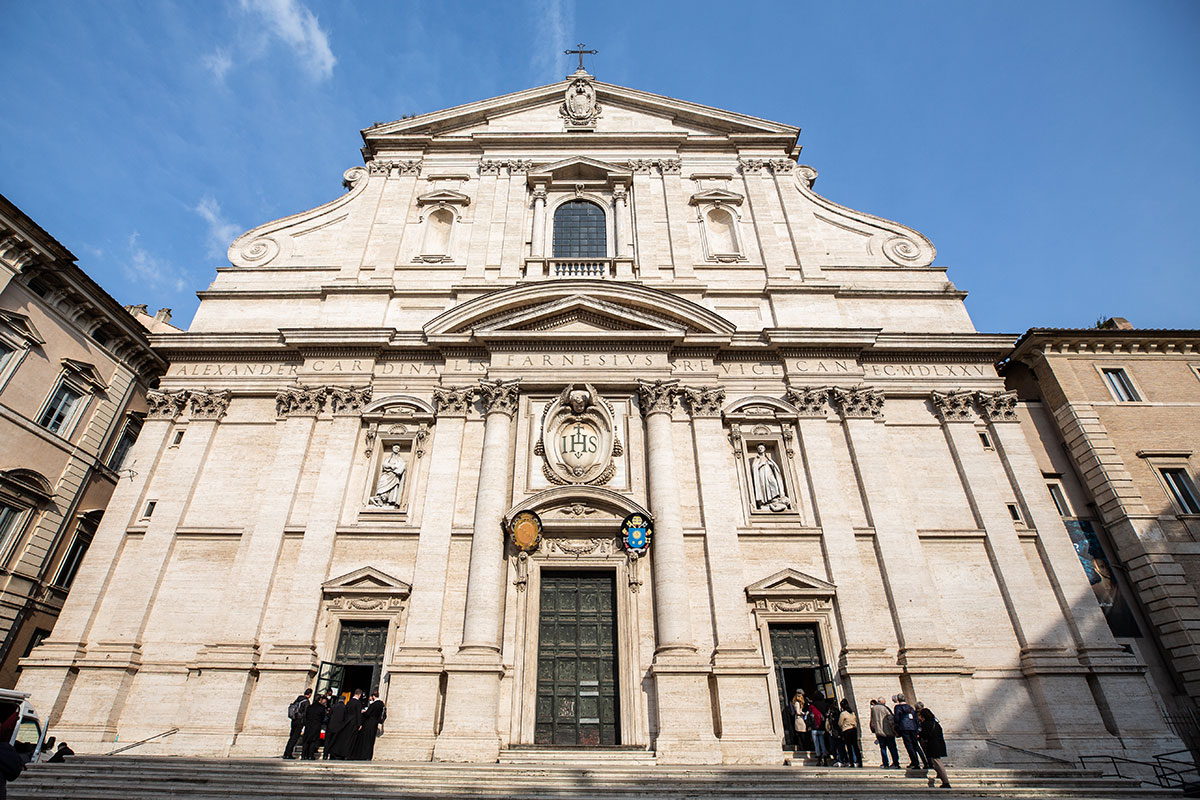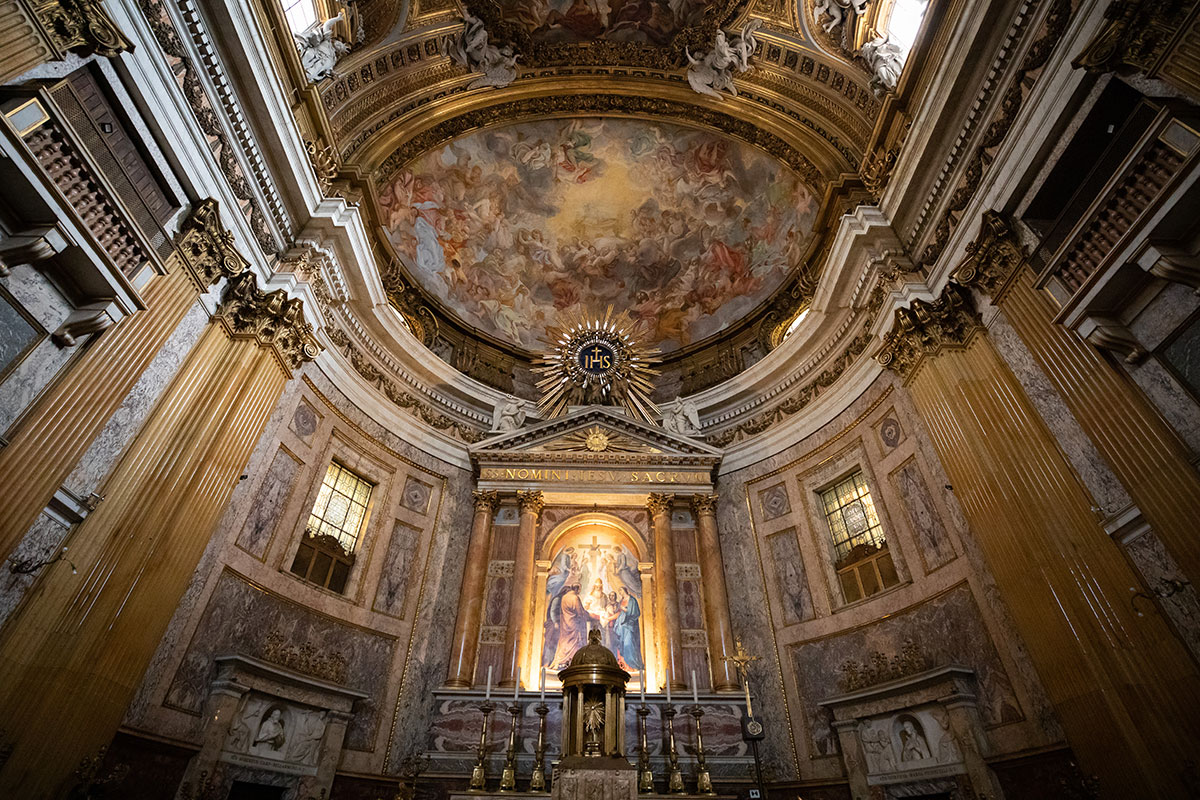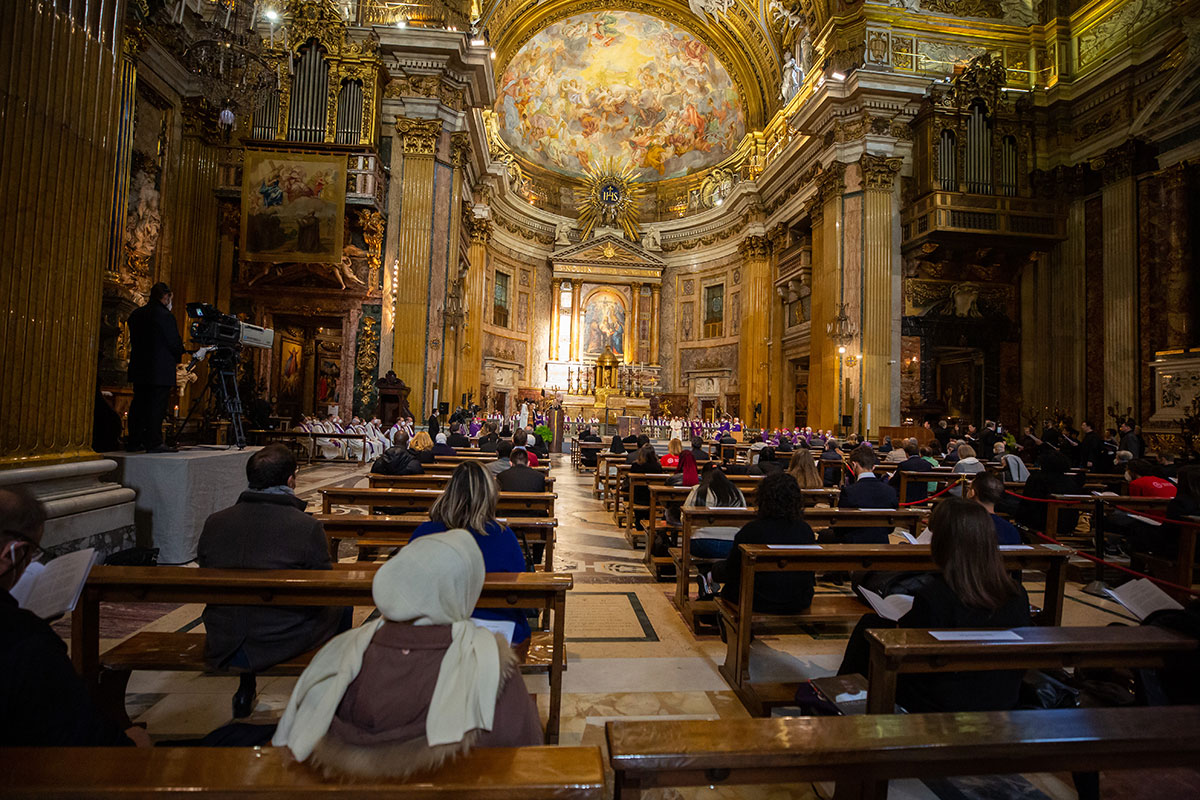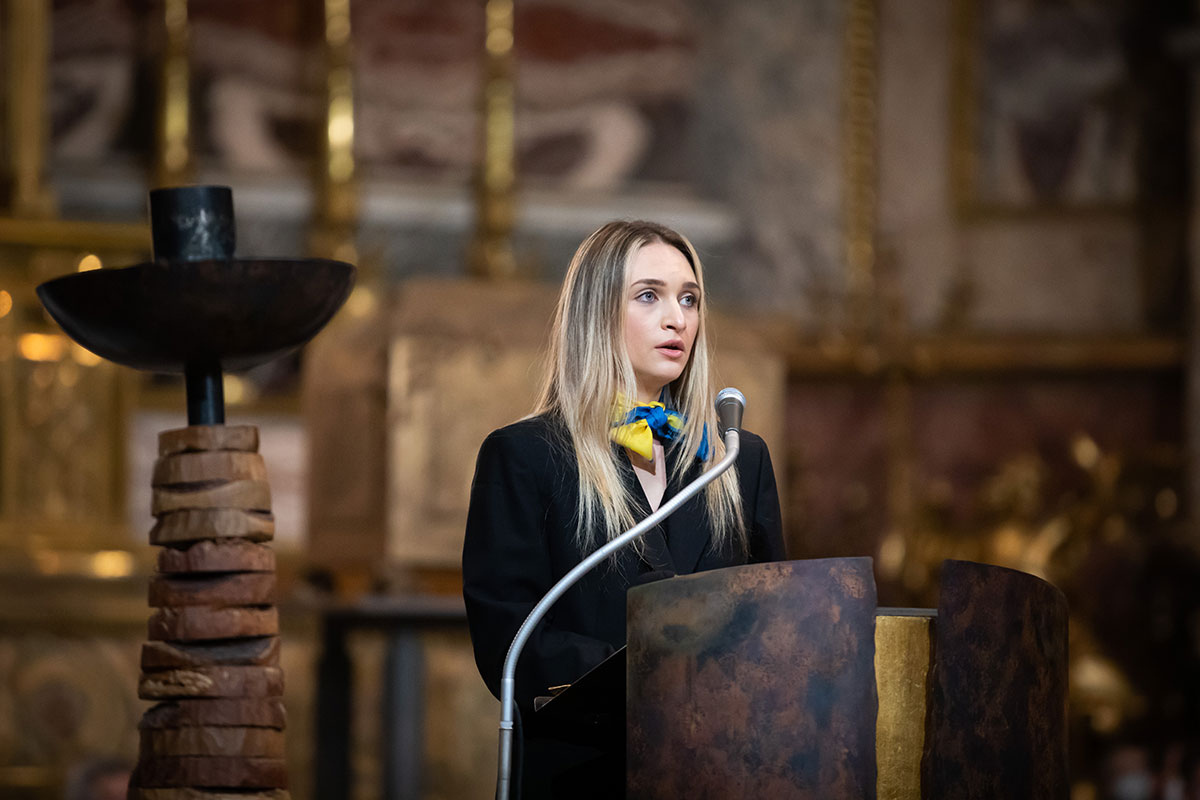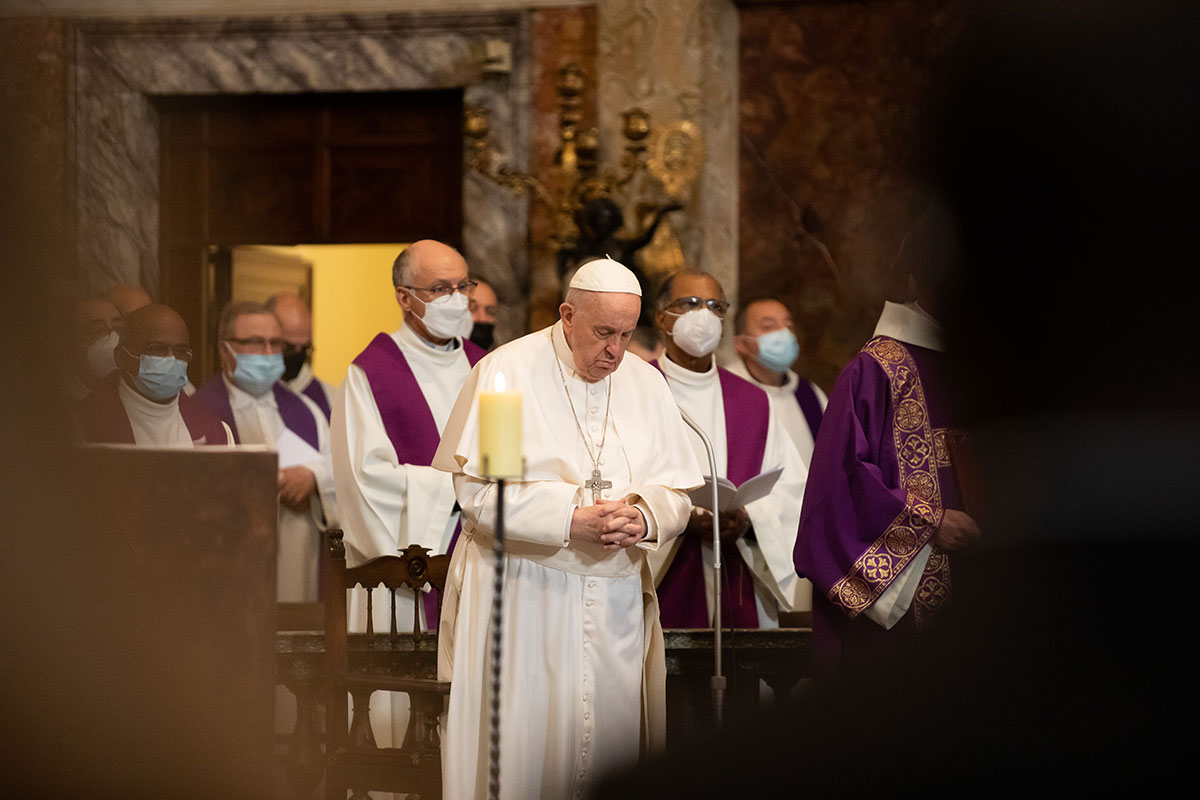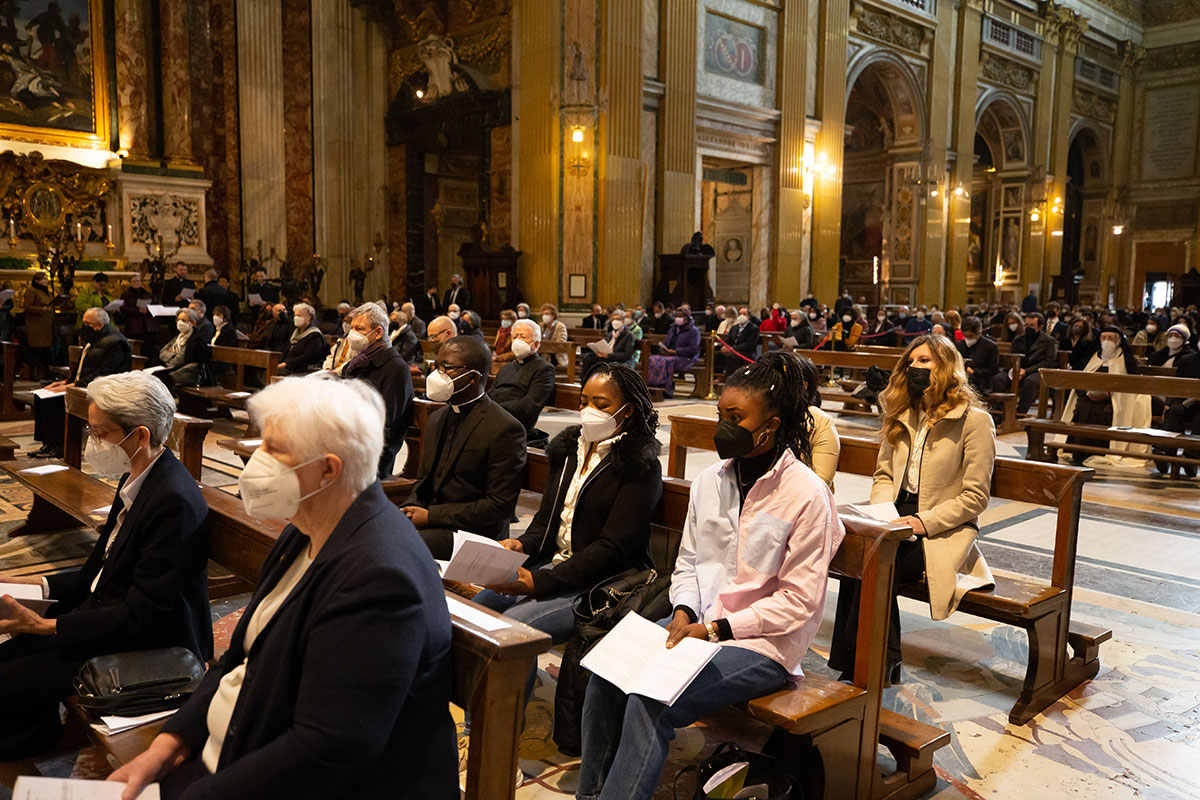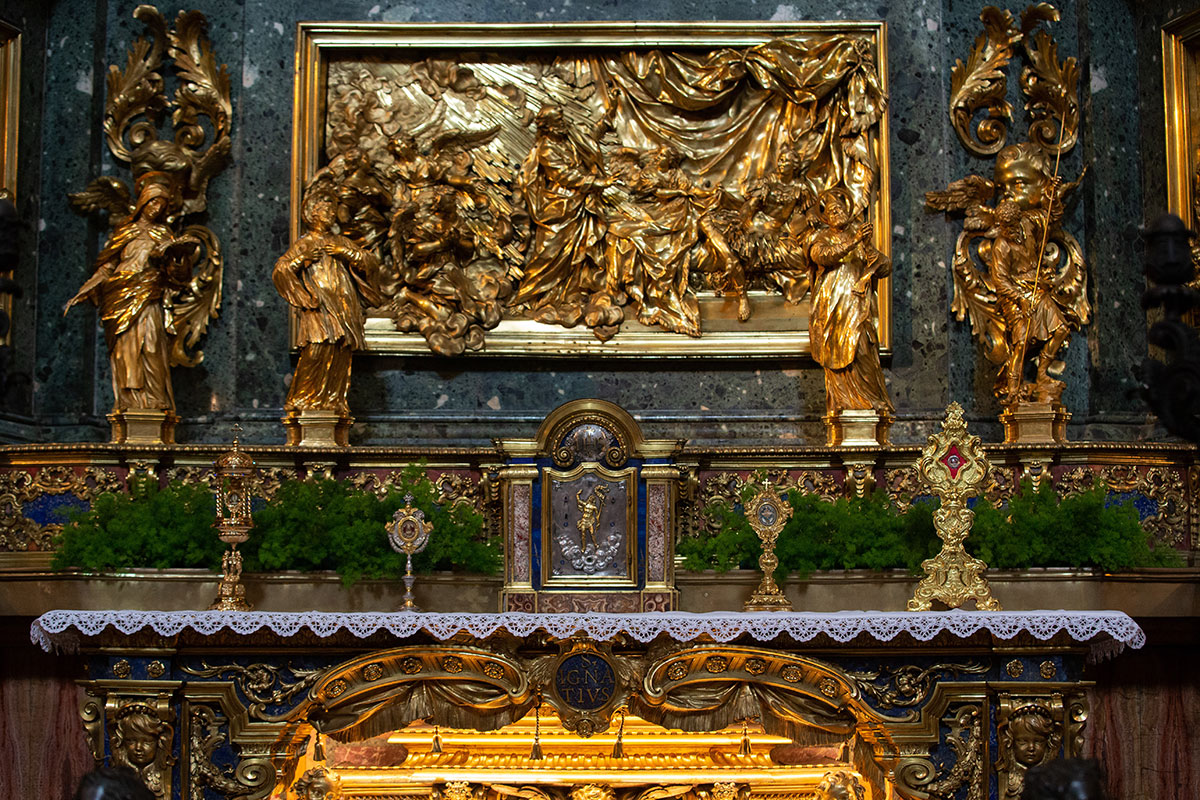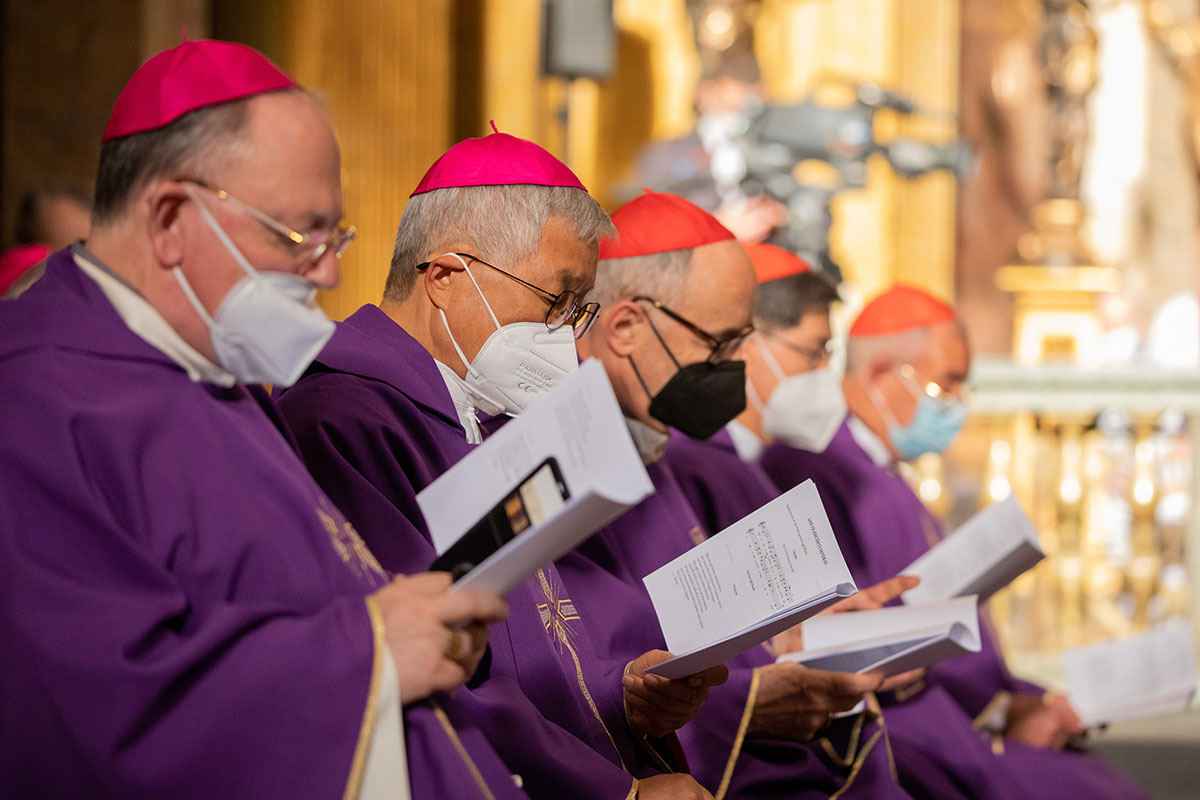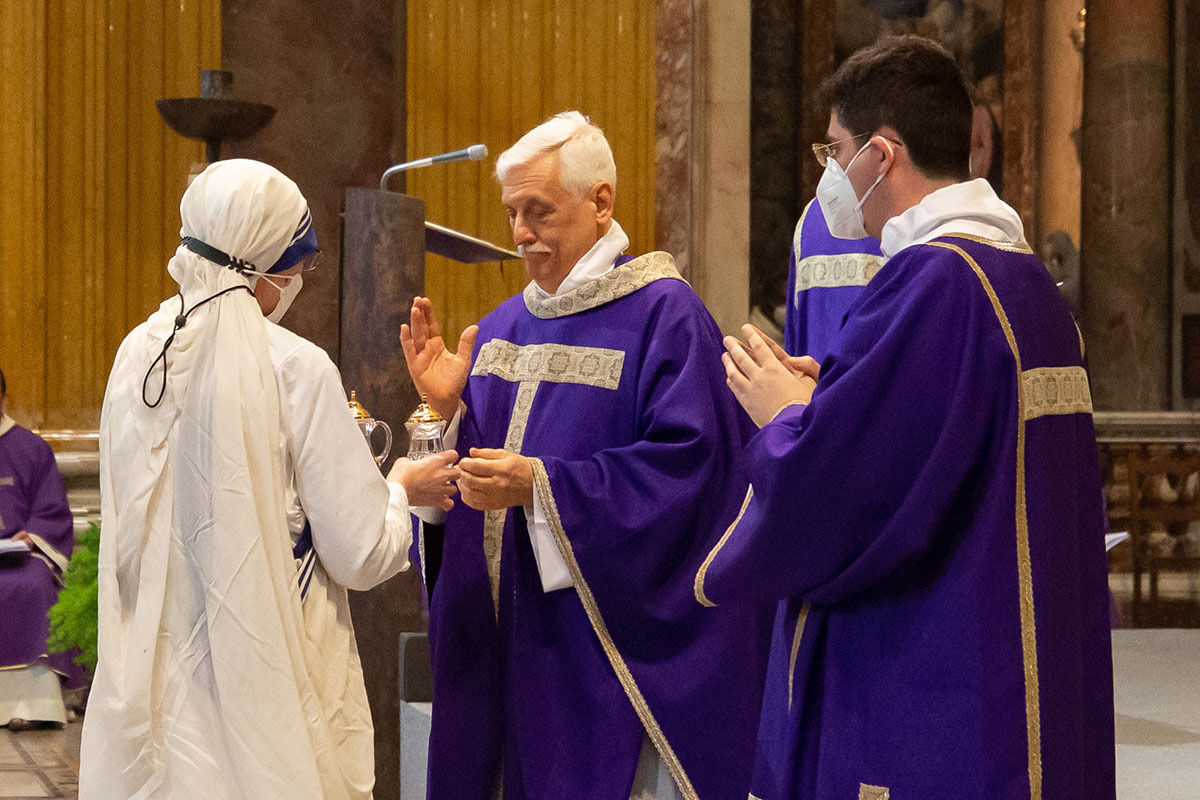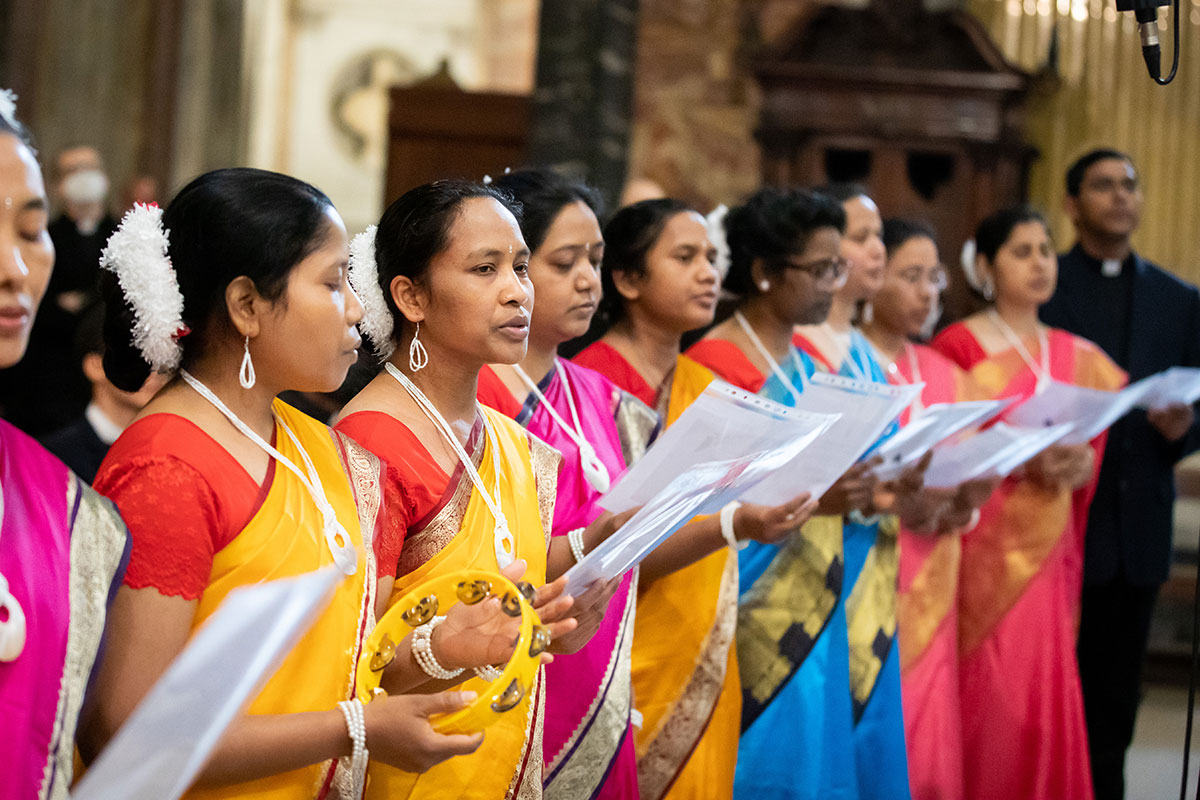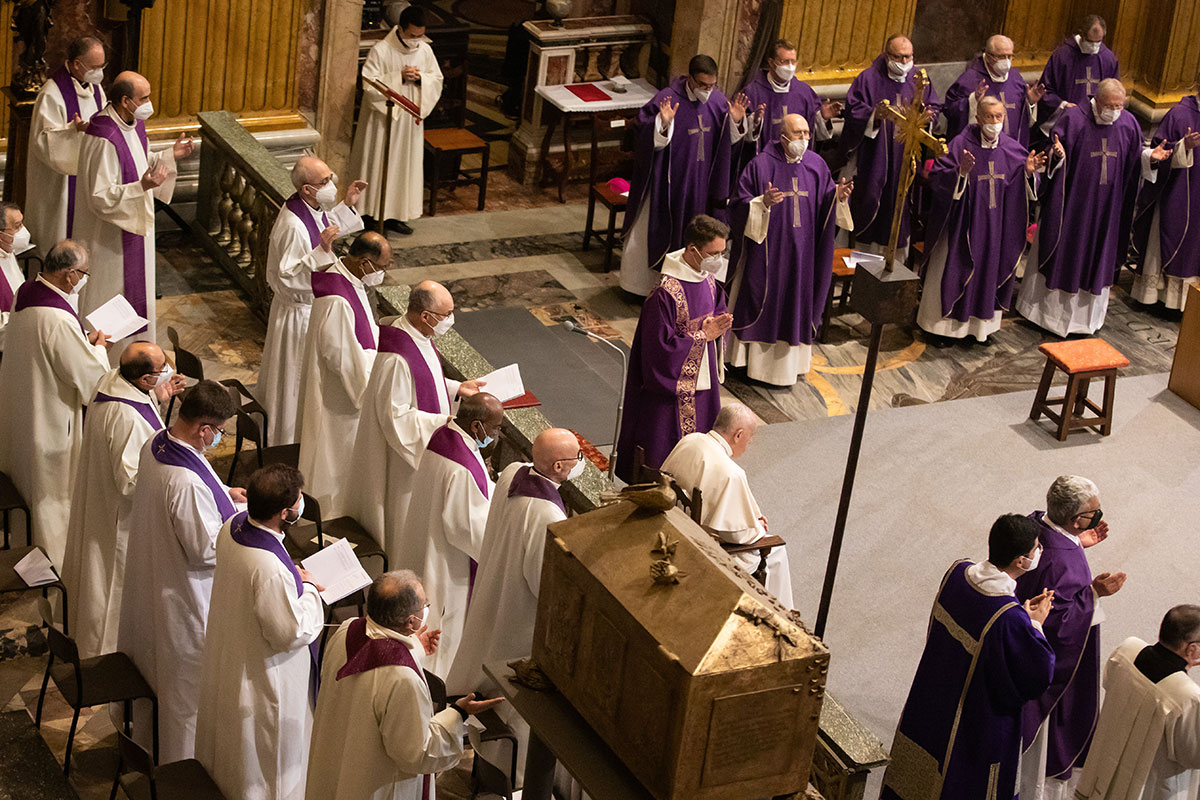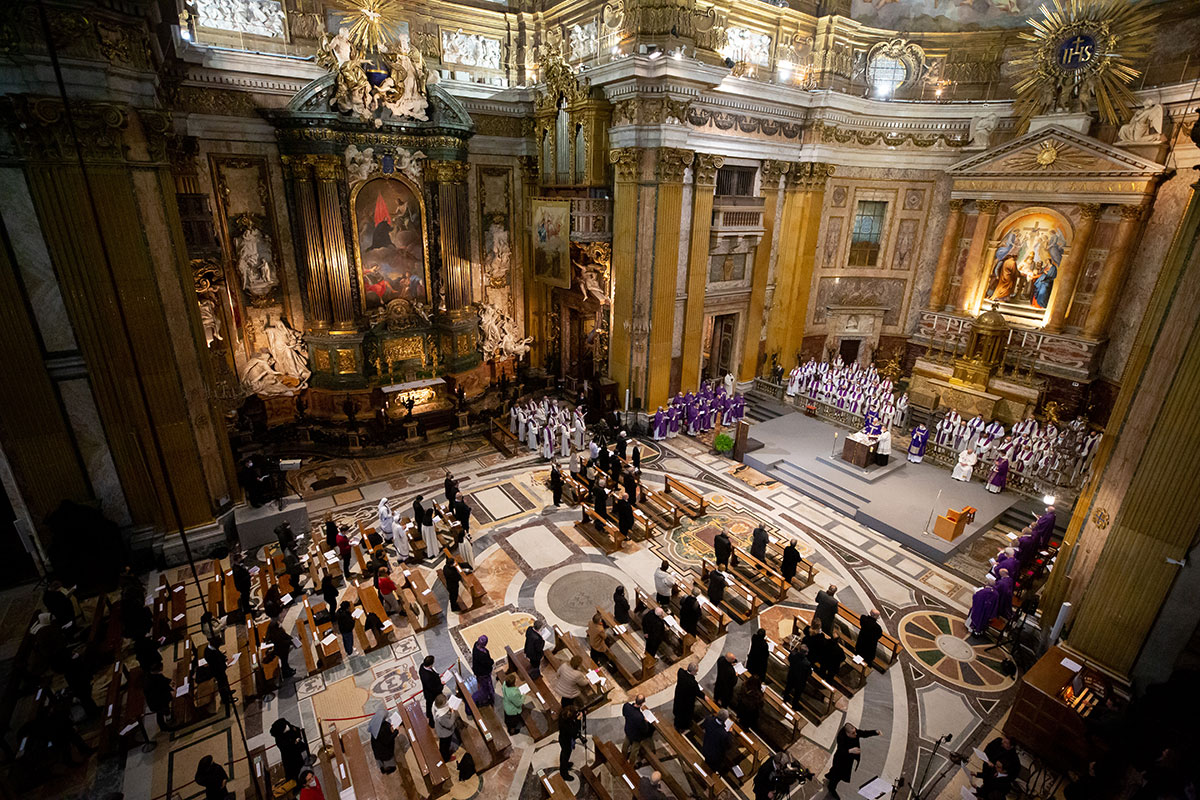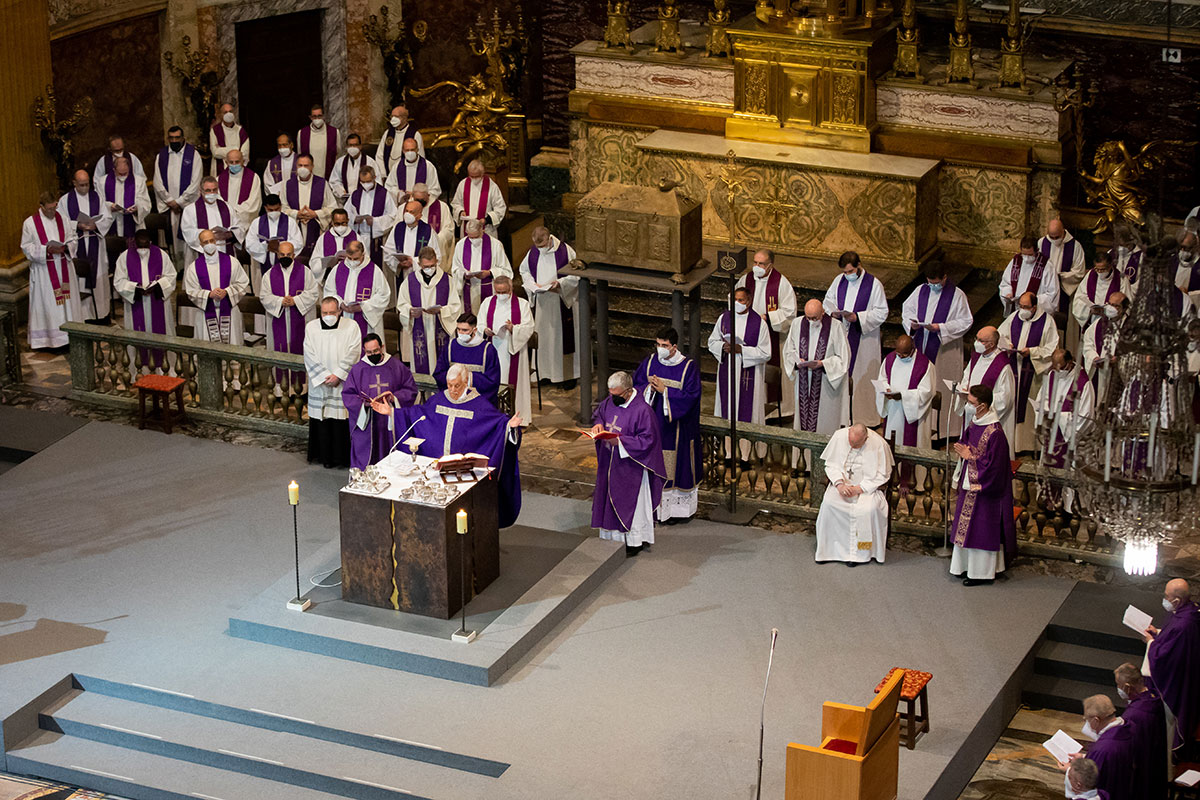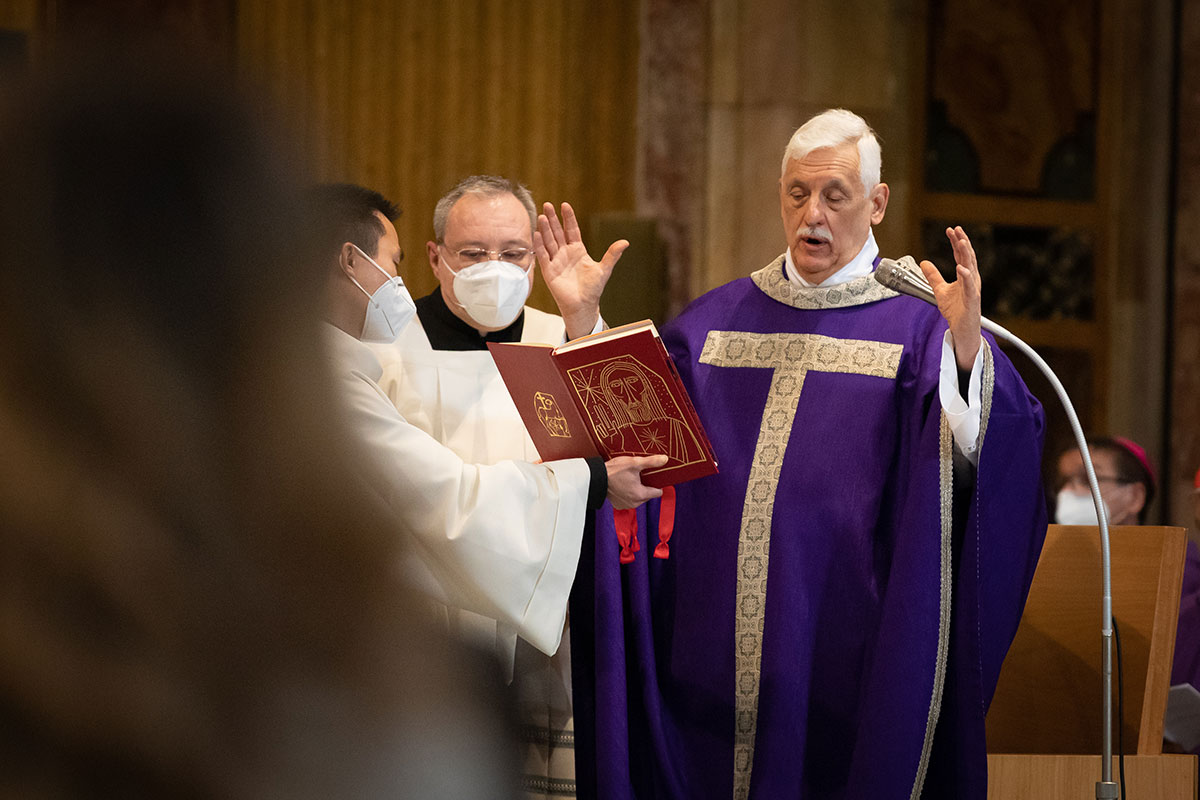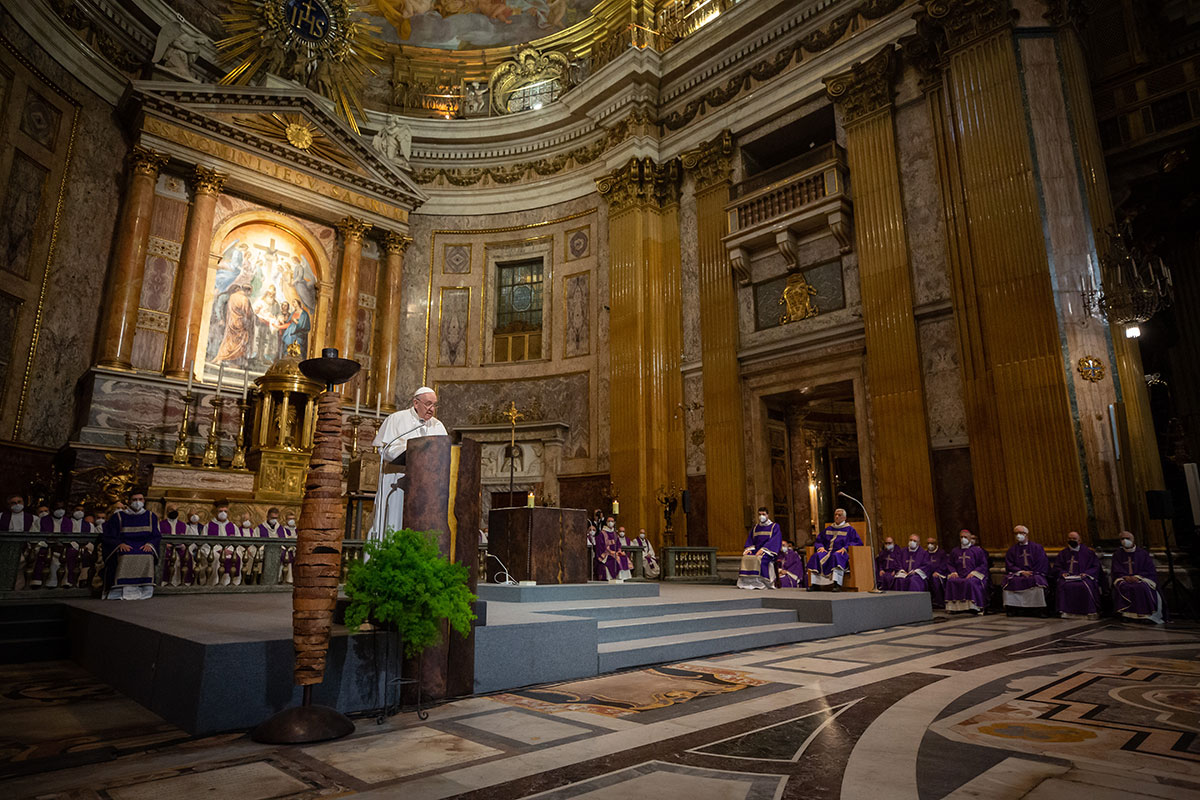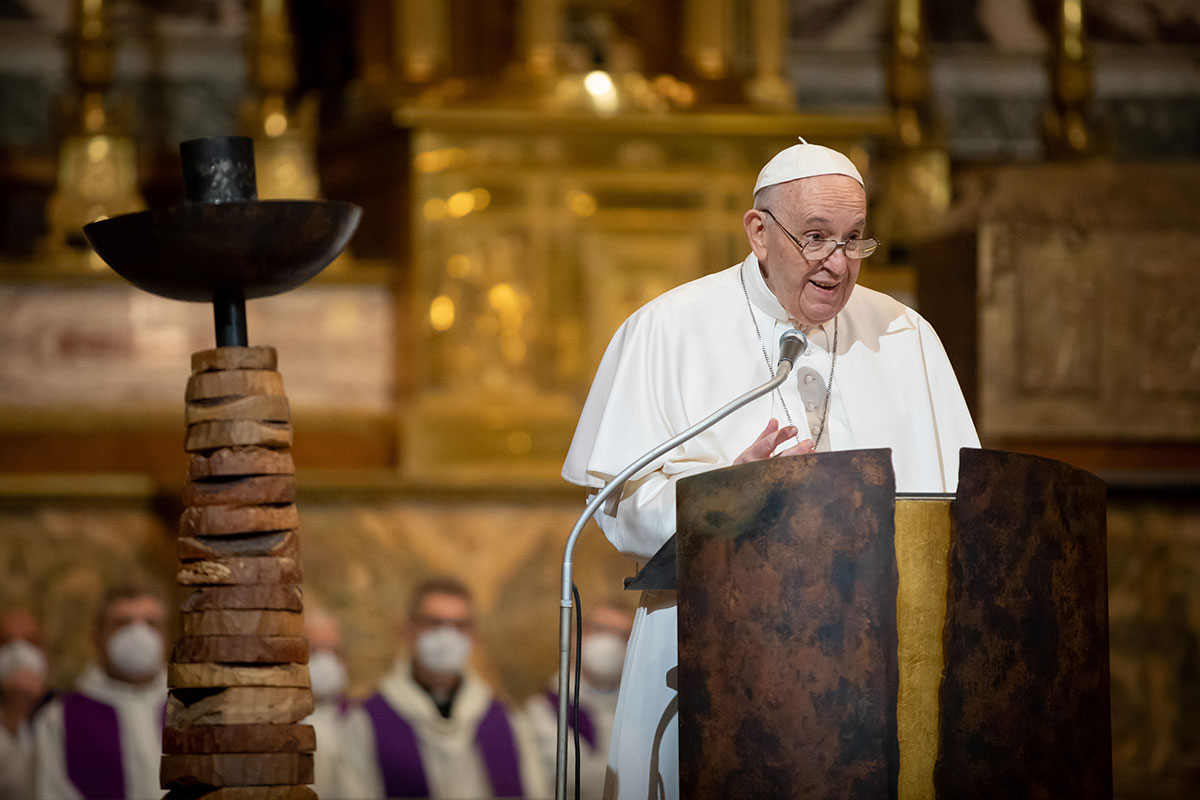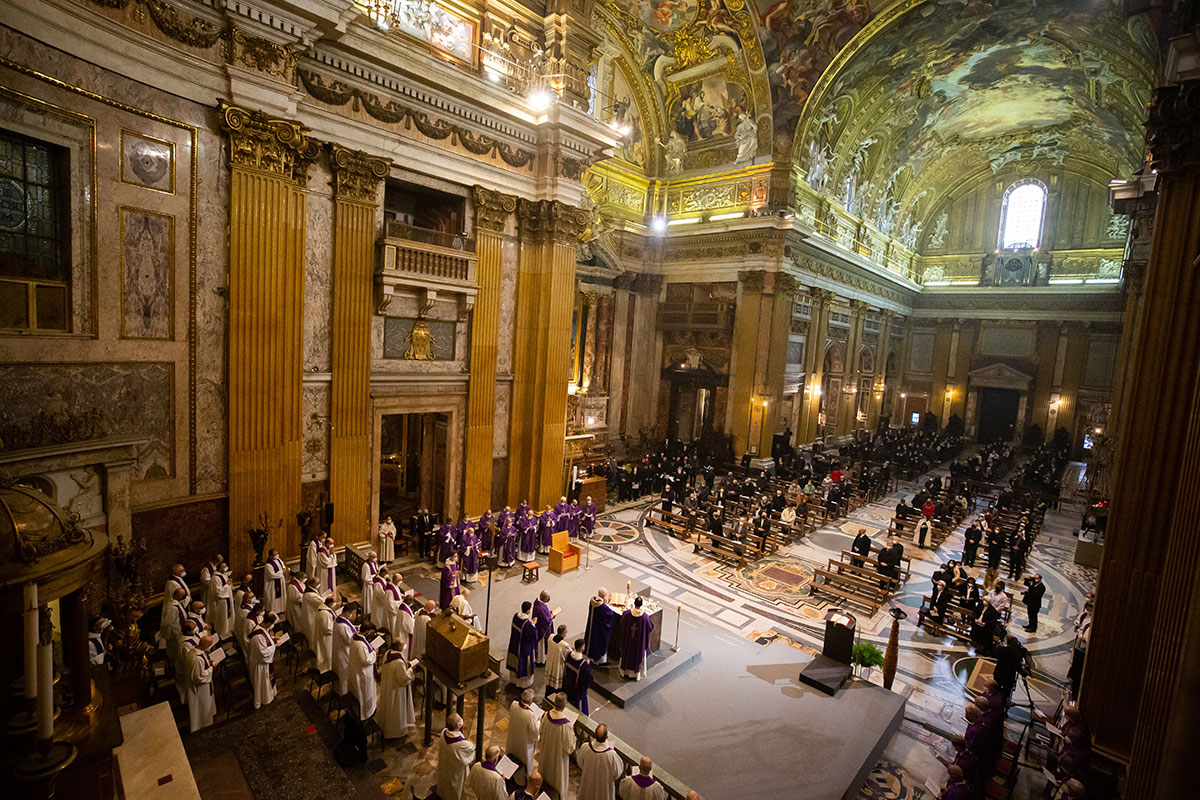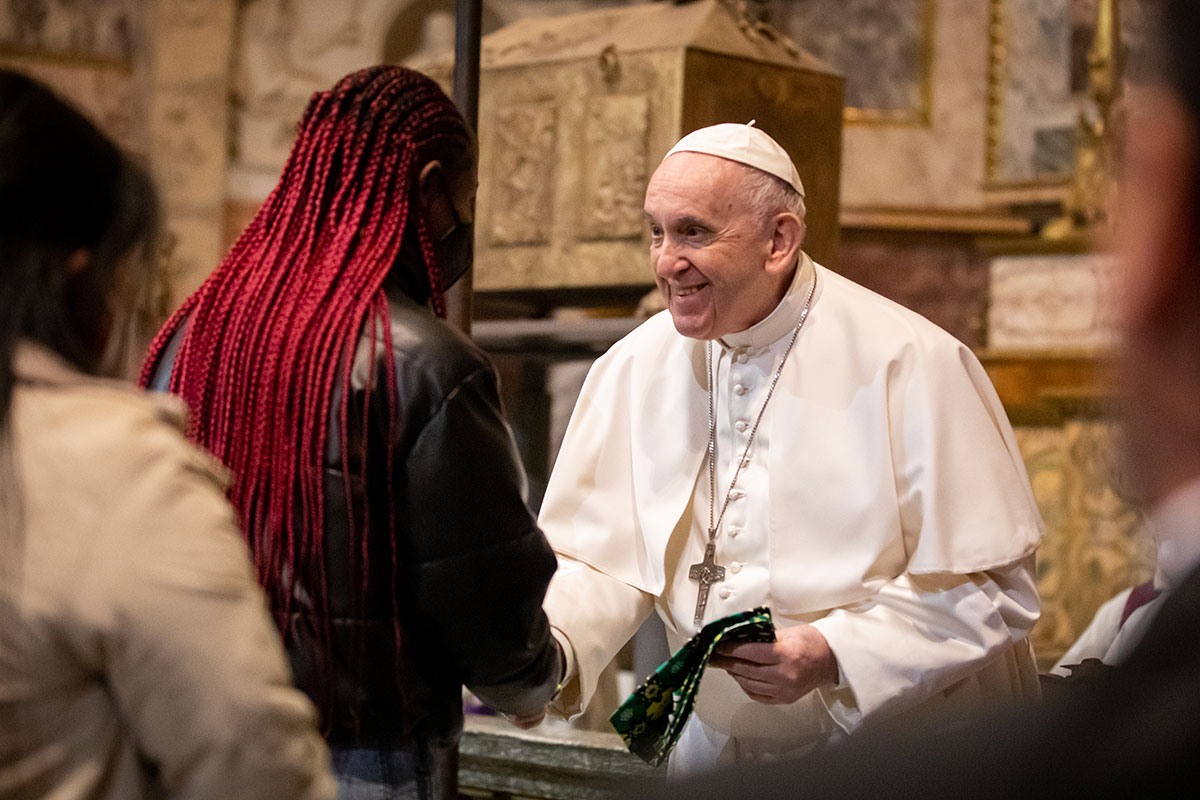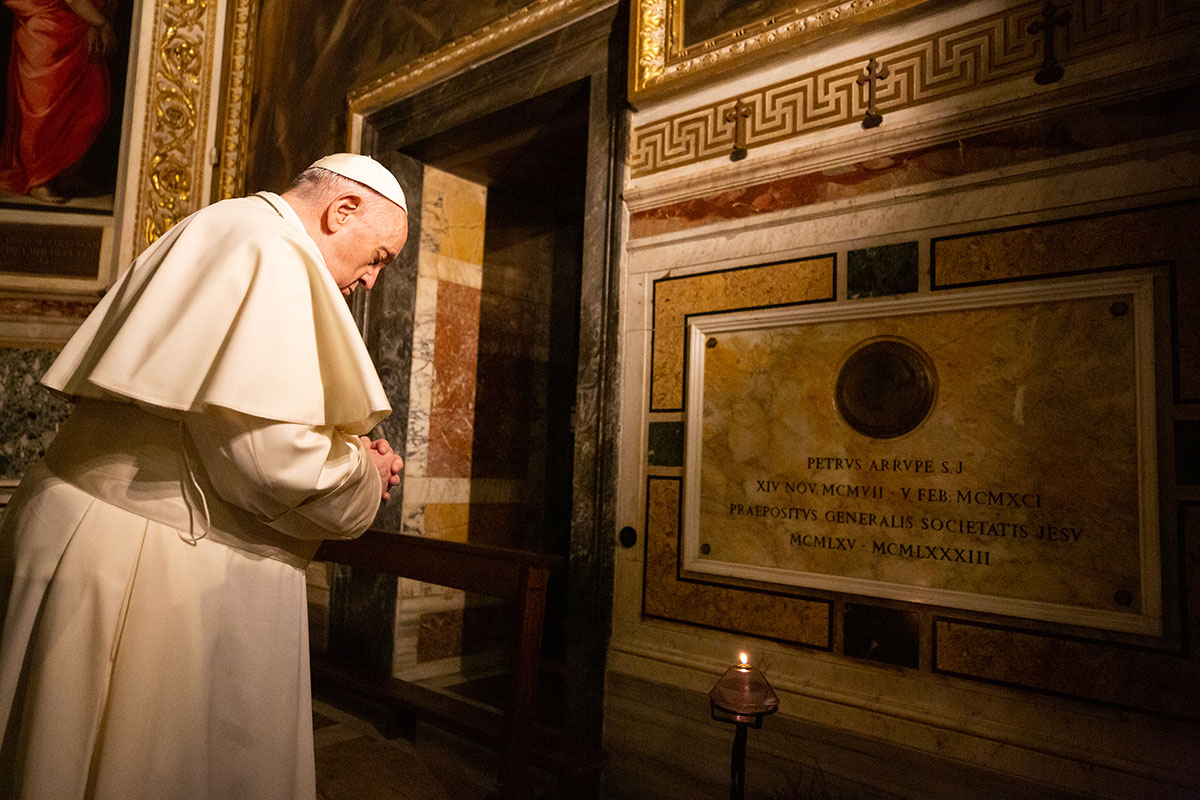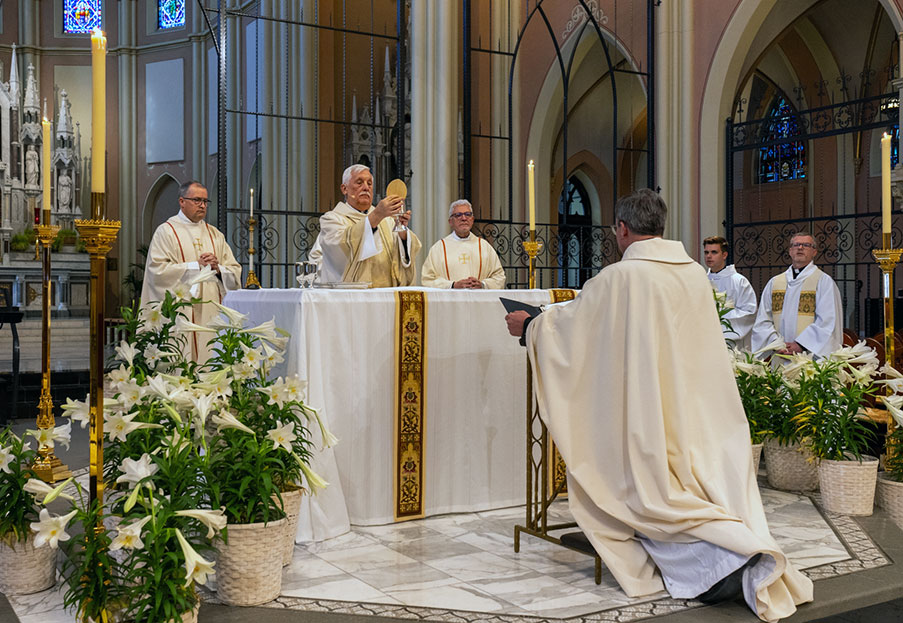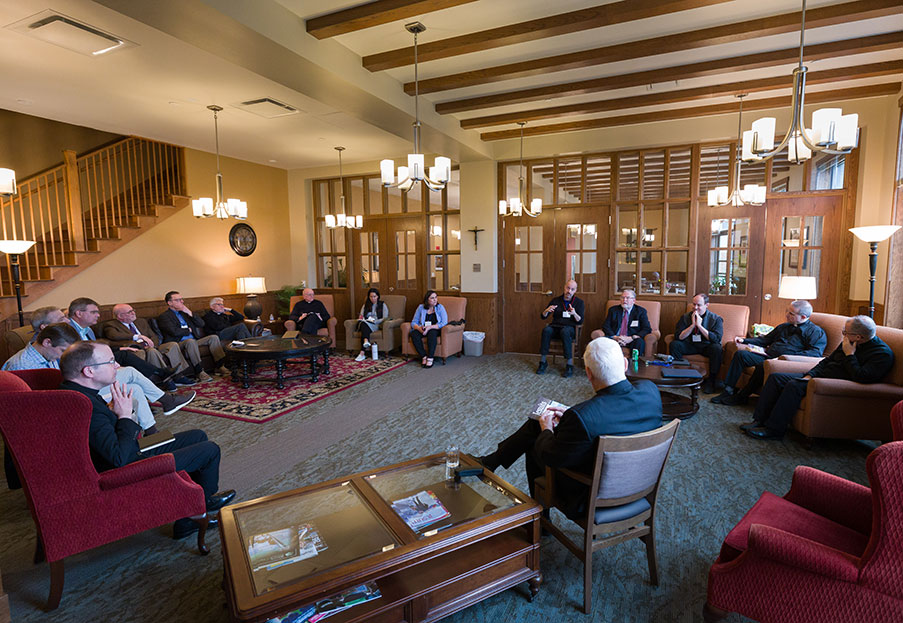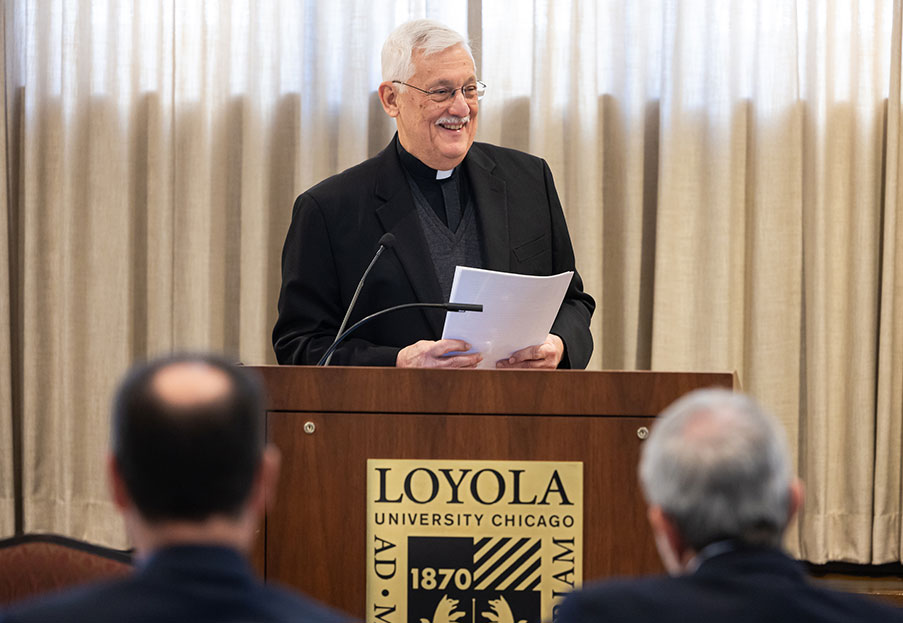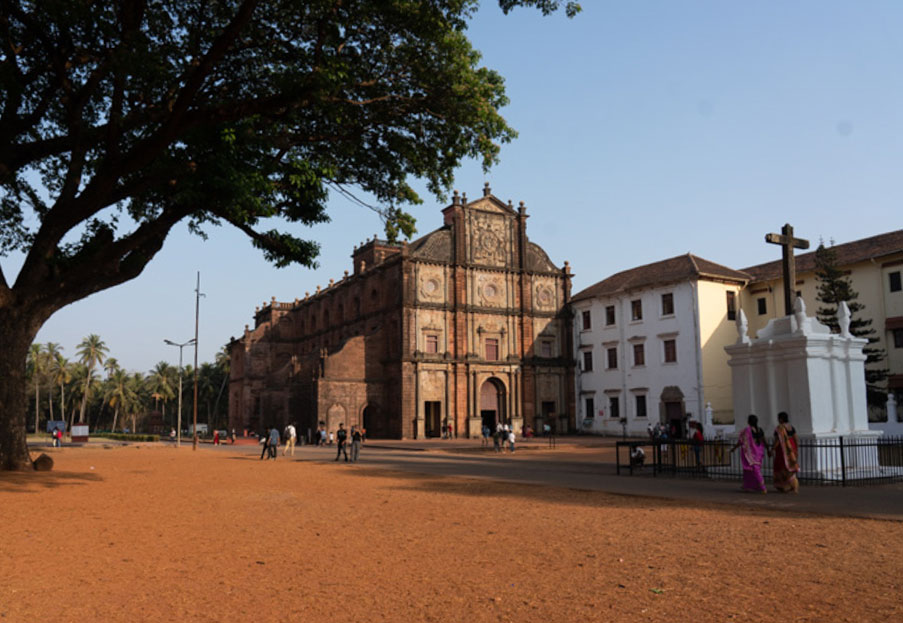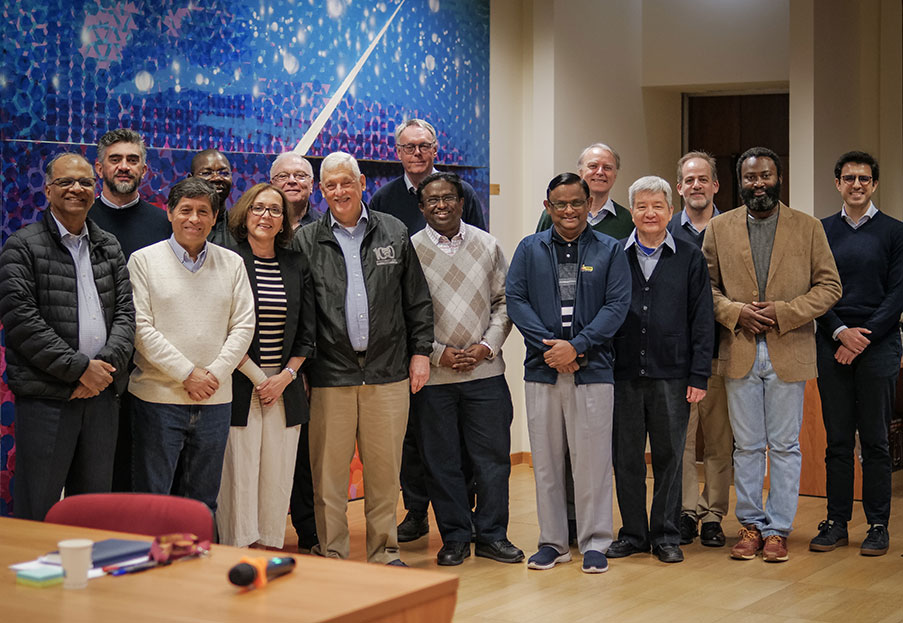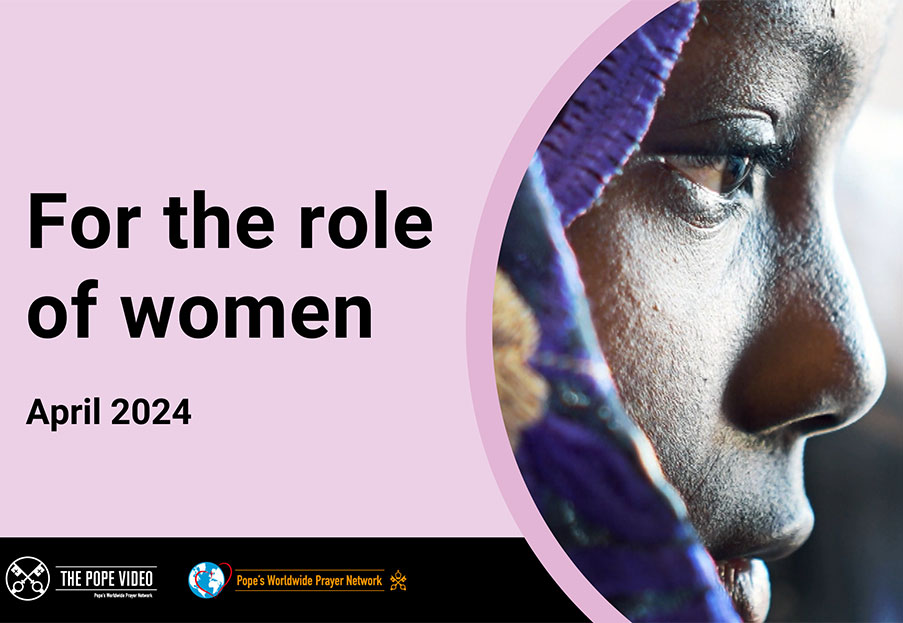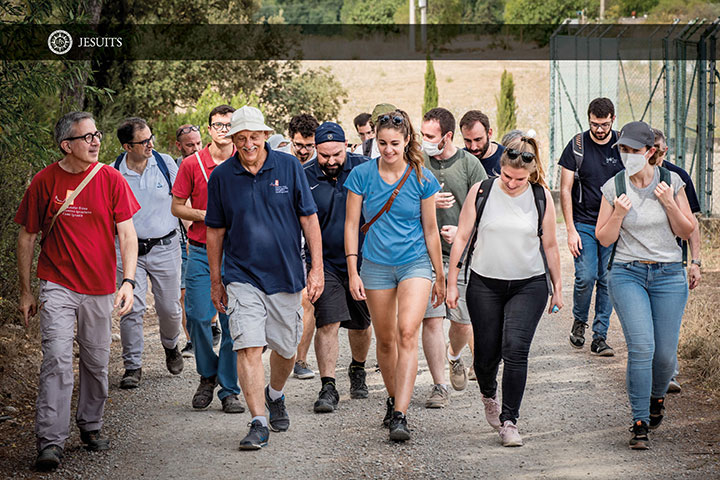Five saints and one feast
400th Anniversary of five canonisations
By Yamid Castiblanco, SJ
Five hundred years ago, because of a leg injury, God broke into the life of Ignatius of Loyola (1491-1556). That wound eventually led Ignatius to put himself at the service of the Pope and the Universal Church and, with a group of companions, to found the Society of Jesus. No one would have thought that this pilgrim, who had first arrived in Rome limping from his wound and with a great desire to imitate Jesus, would a century later, on 12 March 1622, be canonised by Pope Gregory XV in St. Peter's Basilica.
On 12
March 2022, the eve of the ninth year of his pontificate, Pope Francis came to
the Church of the Gesù in Rome to celebrate the anniversary of this canonisation.
The Holy Father, himself with a limp and with a tireless love for the Church
reminiscent of Ignatius, attended this memorial of a life lived with love and
passion.
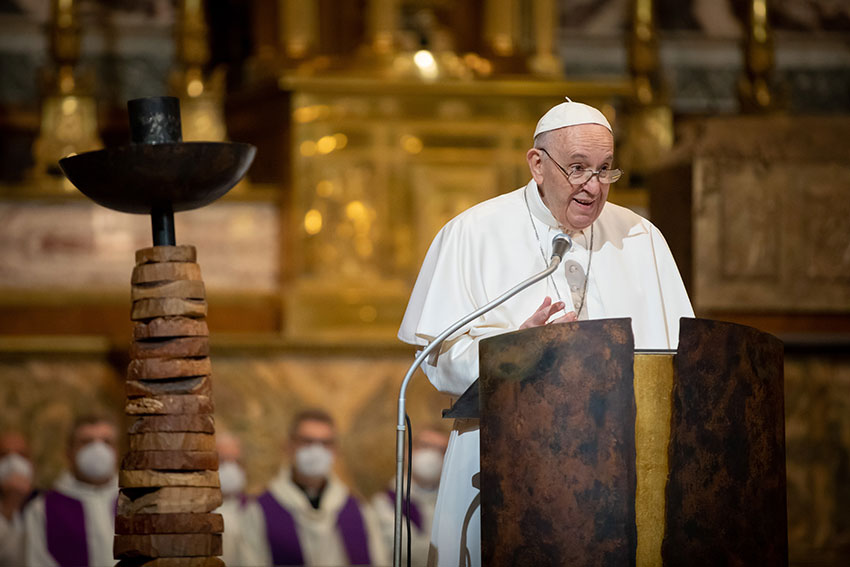
Pope Francis at the Church of the Gesù in Rome, 12 March 2022.
But he did not do so only because of Ignatius Loyola. Because, in addition to Ignatius, the following were also canonised: Francis Xavier (1506-1552), missionary and one of the first Jesuits; Teresa of Jesus (1515-1582), religious sister and mystic, founder of the Discalced Carmelite sisters and Carmelite fathers and brothers; Isidore the Farm Labourer (1079-1172), patron of agricultural workers and of the city of Madrid; and Philip Neri (1515-1595), Italian priest and founder of the Oratorians. “Four Spaniards and a saint”, as has been amusingly commented ever since... especially by Italians. It was the first collective canonisation in history. And so, the Pope came to pray with Jesuits, Oratorians, Carmelites, representatives of the diocese of Madrid as well as countless lay men and women from all over the world, some present and thousands who followed the telecast. The Eucharist was presided by the Superior General of the Jesuits, Arturo Sosa.
Pope Francis emphasised that the immense imprint of these saints, which transcends centuries, nationalities and personalities, is due primarily to the Lord’s initiative. And that initiative, as the Pope recalled as he reflected on the Gospel of the Transfiguration in which “Jesus took with him Peter, James and John”, is a call rooted in the community. In the face of the temptations of individualism, clericalism, rigidity and divisive ideologies... the saints are those who have become “pillars of communion”.
Ignatius
was an example of such communion through his discernment and through his empathy
with the Church - gifts also for us today of his Spiritual Exercises.
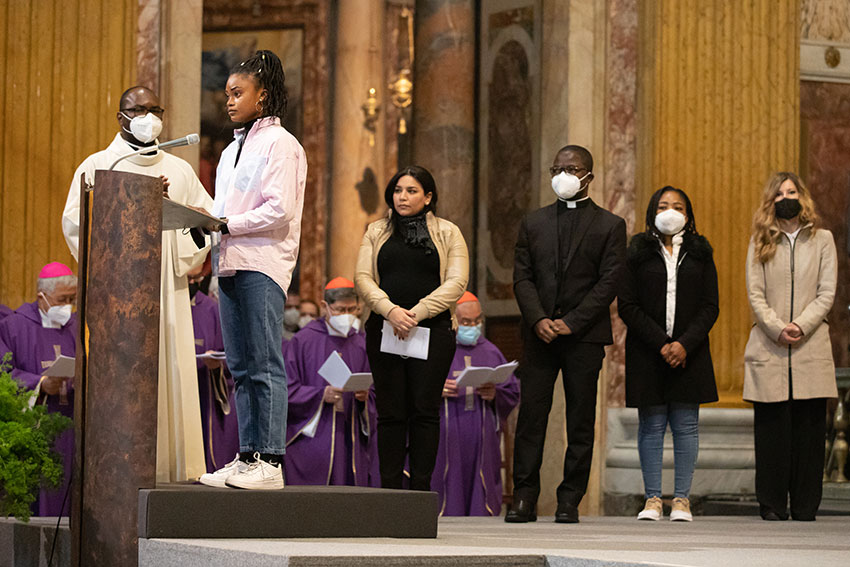
Intercessions, Church of the Gesù in Rome, 12 March 2022.
The Pope referred to the danger of a comfortable and static faith recalling the courage of saints like Teresa. Who climbed with effort the mountain to where earth and heaven meet, “where man ‘confronts’ God”. He recalled Francis Xavier who brought the Gospel to the most unexpected corners of our world and society. In the midst of a reality disfigured by war, injustice and other evils, the Pope finally called for a prayer that does not turn away from a brome world but rather transfigures it, just like Philip Neri did in caring for street children or St. Isidore in working the land.
The
Celebration was marked by other significant moments. We were spellbound as we
heard the heartbreaking words of the Psalm "have mercy on me, answer
me", sung by a young Ukrainian woman. We were moved by the prayer at the tomb of
Ignatius and before the relics of the other four saints; the offering made by
refugees from the Centro Astalli in Rome to the Holy Father; the wonderful
choir of the Collegio del Gesù; and finally, the affection and humility of the
Pope. As Universal Pastor of the Church, Francis presented himself as a
spiritual son of the Society on the anniversary of its two great fathers,
without missing the opportunity to allude to the third of them: Peter Faber,
whom he himself canonised.
Church of the Gesù, Rome
12 March 2022
Today’s Gospel of the Transfiguration presents us with four actions of Jesus. We would do well to dwell on them, in order to discover in these gestures clear directions for our own journey as his disciples.
The first verb is take. Luke tells us that Jesus “took with him Peter, James and John” (9:28). Jesus “takes” the disciples, and he ourselves as well, to be “with him”. Christ loved us, chose us and called us. Everything begins with the mystery of a grace, a choice, an “election”. The first decision was not ours; rather, Jesus called us, apart from any merit on our part. Before becoming men who make their lives a gift, we are persons who received a gift freely given. Our journey, brothers, needs to start anew each day from this initial grace. As he did with Peter, James and John, Jesus has called us by name and taken us with him. Where? To his holy mountain, where even now he sees us with himself forever, transfigured by his love. Grace leads us there. So, when we feel bitterness or disappointment, when we feel belittled or misunderstood, let us not wander off into complaints or nostalgia for bygone times. These are temptations that block our progress, that lead us nowhere. Instead, let us take matters in hand, starting anew with grace. Let us accept the gift of seeing each day as a step along the way towards our ultimate goal.
Jesus took with him Peter, James and John. The Lord takes the disciples together; he takes them as a community. Our vocation is grounded in communion. To start anew each day, we need to experience once more the mystery of our election and the grace of living in the Church, our hierarchical Mother, and for the Church, our spouse. We belong to Jesus, and we belong to him as a Society. Let us never tire of asking for the strength to form and foster communion, to be a leaven of fraternity for the Church and for the world. We are not soloists in search of an audience, but brothers arranged as a choir. Let us think with the Church and reject the temptation to be concerned about our own personal success or attainments. Let us not allow ourselves to be sucked into a clericalism that leads to rigidity or an ideology that leads to divisiveness. The saints we commemorate today were pillars of communion. They remind us that, for all our differences of character and viewpoint, we have been called to be together. If we will be forever united in heaven, why not begin here? Let us cherish the beauty of having been “taken”, brought together, by Jesus.
A second verb is go up. Jesus “went up the mountain” (v. 28). Jesus’ path is one of ascent, not descent. The light of the transfiguration is not seen on the plain, but only after a strenuous ascent. In following Jesus, we too need to leave the plains of mediocrity and the foothills of convenience; we need to abandon our reassuring routines and set out on an exodus. Jesus, after going up the mountain, speaks to Moses and Elijah precisely about the “exodus, which he was to accomplish in Jerusalem” (v. 31). Moses and Elijah had gone up to Sinai or Horeb after two “exodus” experiences in the desert (cf. Ex 19; 1 Kings 19); now they speak with Jesus about the definitive exodus, that of his Pasch. Brothers, only the ascent of the cross leads to the goal of glory. This is the way: from the cross to glory. The worldly temptation is to seek glory in bypassing the cross. We would prefer paths that are familiar, direct and smooth, but to encounter the light of Jesus we must continually leave ourselves behind and follow him upwards. The Lord who, as we heard, first “brought Abraham outside” (Gen 15:5), also invites us to move outwards and upwards.
For us Jesuits, this journey of moving outwards and upwards follows a specific path, nicely symbolized by the mountain. In Scripture, mountain peaks represent the extremity, the heights, the border between heaven and earth. We are called to go precisely there, to the border between heaven and earth where men and women “confront” God with their difficulties, so that we in turn can accompany them in their restless seeking and their religious doubt. That is where we need to be, and to do so, we have to go outwards and upwards. The enemy of human nature would persuade us to keep to the path of empty but comfortable routines and familiar landscapes, whereas the Spirit impels us to openness and to a peace that never leaves us in peace. He sends disciples to the utmost limits. We need think only of Francis Xavier.
In every age, Christ’s disciples find themselves before this crossroads. We can act like Peter, who responds to Jesus’ prediction of his exodus by saying, “It is good to be here” (v. 33). This is the risk of a static faith, a “neatly parked” faith, in which we consider ourselves “respectable” disciples, but are not in fact following Jesus; instead, we passively stay put, and, without realizing it, doze off like the disciples in the Gospel. In Gethsemane too, the same disciples would fall asleep. Brothers, for the followers of Jesus, now is not a time for sleeping, for letting our souls be sedated, anesthetized by today’s consumerist and individualistic culture, by the attitude of “life is good as long as it’s good for me”. In that way, we can continue speak and theorize, while losing sight of the flesh of our brothers and sisters, and the concreteness of the Gospel. One of the great tragedies of our time is the refusal to open our eyes to reality and instead to look the other way. Saint Teresa helps us to move beyond ourselves, to go up the mountain with the Lord, to realize that Jesus also reveals himself through the wounds of our brothers and sisters, the struggles of humanity, and the signs of the times.
The Gospel tells us that Jesus went up the mountain “to pray” (v. 28). This is the third verb: to pray. “And as he was praying, the appearance of his countenance was altered, and his clothing became dazzling white” (v. 29). The Transfiguration was born of prayer. Let us ask ourselves, even after many years of ministry, what does it mean today for us to pray? Perhaps force of habit or a certain daily ritual has led us to think that prayer does not change individuals or history. Yet to pray is to change reality. Prayer is an active mission, a constant intercession. It is not distant from the world, but changes the world. To pray is to bring the beating heart of current affairs into God’s presence, so that his gaze will shine out upon history.
We would do well to ask ourselves if prayer immerses us in this change. Does it shed new light upon others and transfigure their situations? For if prayer is living, it “unhinges” us from within, reignites the fire of mission, rekindles our joy, and continually prompts us to allow ourselves to be troubled by the plea of all those who suffer in our world. Let us also ask ourselves how we are bringing the present war to our prayers. We think of the prayer of Saint Philip Neri, which expanded his heart and made him open his doors to the street children of the Rome of his time. Or of Saint Isidore, who prayed in the fields and brought his farm work to his prayer.
Taking up each day anew our individual calling and our community history; then going up towards the heights that God points out to us; and praying in order to change this world in which we are immersed.
Yet there is also a fourth verb, which appears in the last verse of today’s Gospel: “Jesus remained alone” (v. 36). He remained, while everything else passed away except for the echo of the Father’s “testimony”: “Listen to him” (v. 35). The Gospel concludes by leading us back to what is essential. We are often tempted, in the Church and in the world, in our spirituality and in our society, to give primary importance to many secondary needs. In a word, we risk focusing on customs, habits and traditions that set our hearts on passing things and make us forget what remains. How important it is for us to work on our hearts, so that they can distinguish between the things of God that remain, and worldly things that pass away!
Dear brothers, may our Holy Father Ignatius help us to preserve discernment, our precious legacy, as an ever timely treasure to be poured out on the Church and on the world. For discernment enables us to “see anew all things in Christ”. Indeed, discernment is essential, so that, as Saint Peter Faber wrote, “the good that can be achieved, thought or organized, may be done with a good, not a malign, spirit” (cf. Memorial, Paris, 1959, n. 51).
